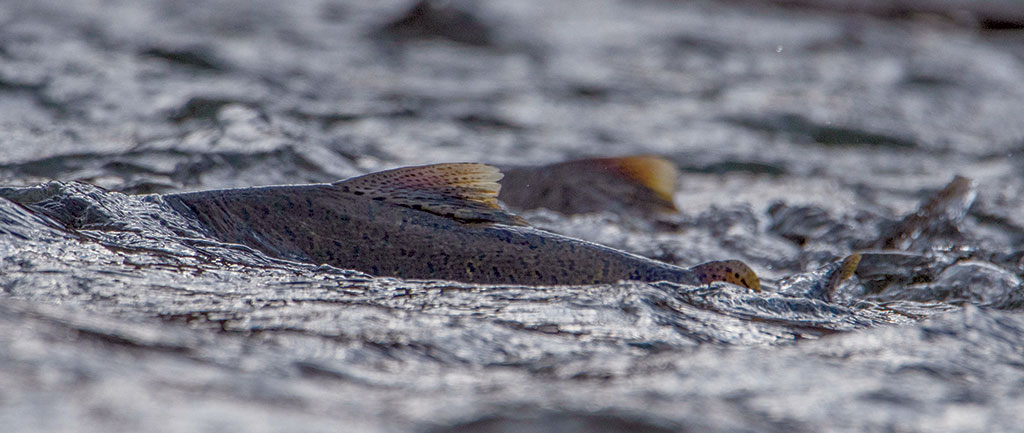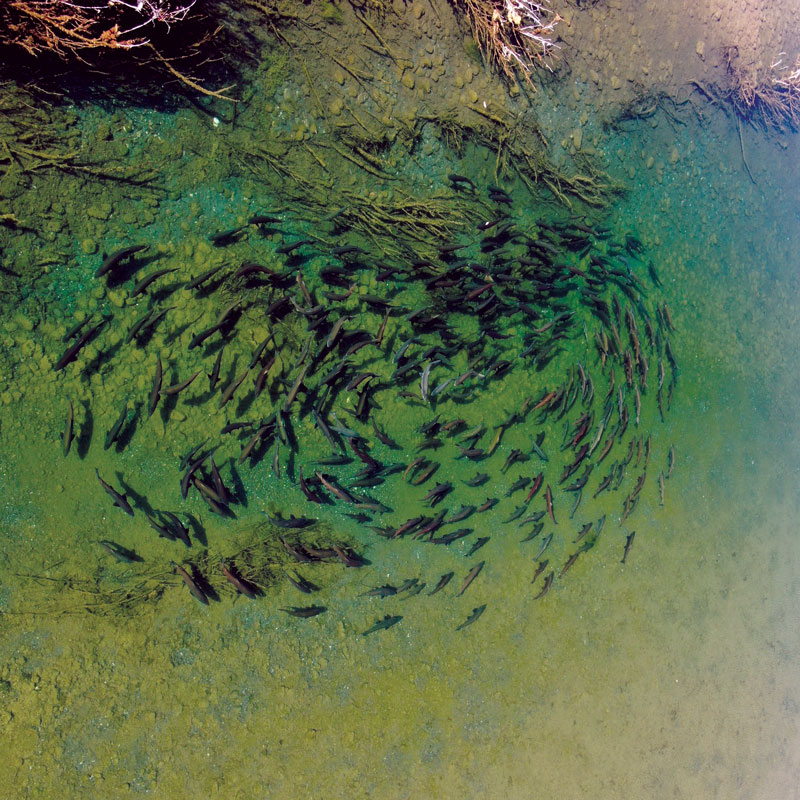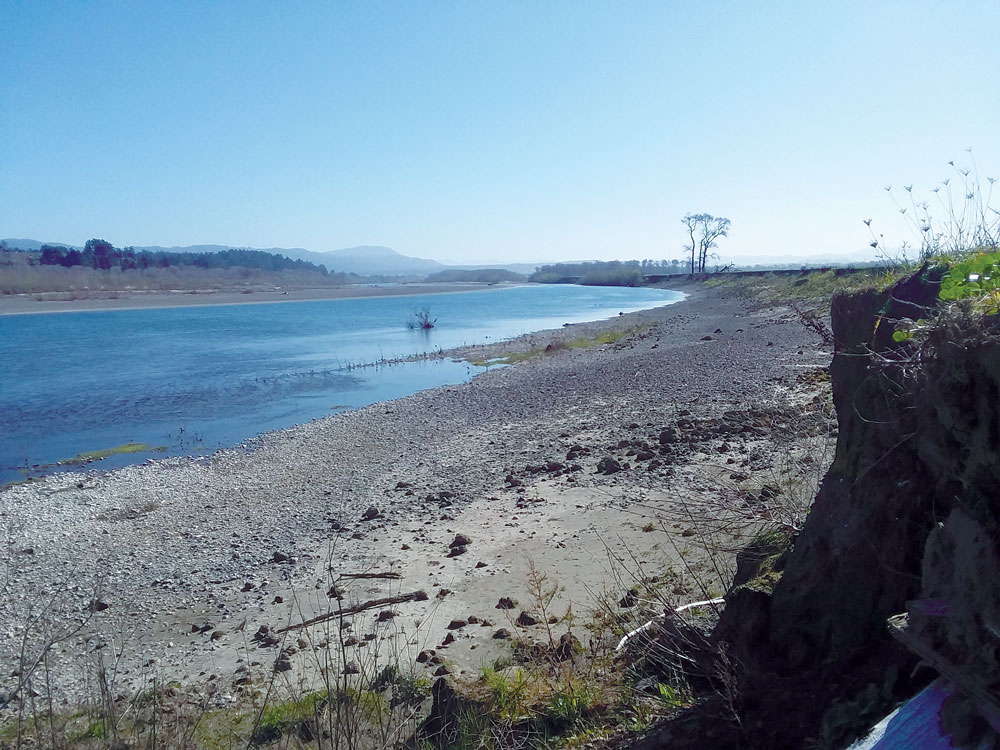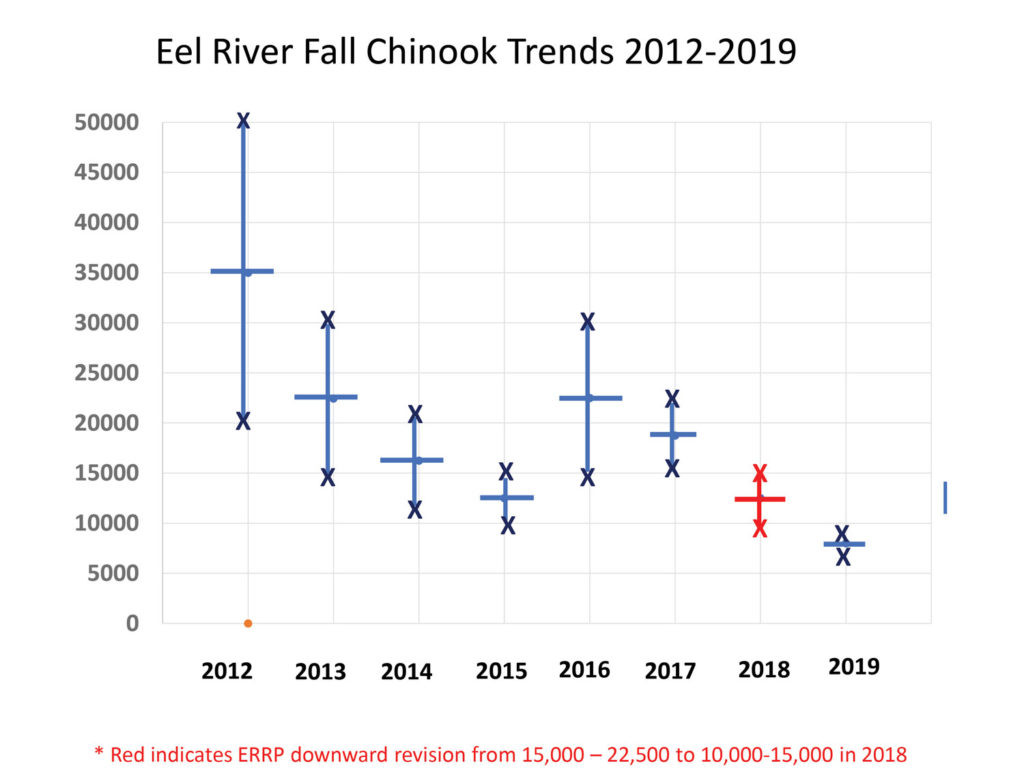Eel River Fall Chinook 2019–2020 Run Declines Due to Variable Ocean Conditions

Eel River Recovery Project

Times are changing in the world of salmon assessment on the Eel River as technology provides more accurate counts than people can, with sonar in the river and drones in the sky. But the data does not provide good news about fish-run trends. The 2019–2020 fall Chinook Salmon escapement (the number of salmon that “escape” ocean fisheries and return to the river to spawn) was the first to dip below 10,000 fish since the Eel River Recovery Project (ERRP) began assessments in 2012. In this report we describe this year’s run, look into what is causing the decline, and make suggestions about what we can do to help Eel’s Chinook Salmon survive in a changing world.
The California Department of Fish and Wildlife (CDFW) has operated a Dual Frequency Identification Sonar (DIDSON) device on the main Eel above Dyerville for the last two years. They estimated that 4,110 Chinook Salmon migrated past that point between November and early January 2020, versus 3,844 the year prior. CalTrout operated a similar unit on the lower South Fork Eel River and found only about 2,000 Chinook in 2019–2020, versus 3,800 last year at the same site.
Early fall Chinook counts in the lower Eel River were a harbinger. Since 2015, Eric Stockwell has conducted stand-up paddleboard surveys of the lower Eel from late August until rain boosts flow in October or November and the fish begin their migration to the headwaters to spawn. David Sopjes, a retired Ferndale High School teacher, mastered drone photography of the lower Eel River over the last two years and got precise salmon counts from his photos in 2019 using DotDotGoose software that was developed for estimating water fowl numbers from photos.

Eric and Dave estimated that 1,500 Chinook Salmon were holding in the lower Eel River on October 29, 2019. By way of comparison, on October 27 in 2012, an ERRP dive team counted 5,036 salmon in this part of the river.
CDFW and CalTrout found that the main pulse of Chinook Salmon occurred in association with the rain just after Thanksgiving, but there was no late pulse of new fish as additional rains came. Some fish spawned below Dyerville in the main Eel River starting in late November, but at very low densities and they likely numbered just a few hundred. Later-season surveys of lower Eel tributaries like Howe Creek and Bear Creek found no spawners and no redds (salmon nests).
In the South Fork Eel River basin, the run was delayed by low flows, and most Chinook fish spawned in the main South Fork upstream of Leggett. Flows were too late to expand distribution into upper Tenmile Creek, which has some of the most productive spawning areas in the Eel River watershed. Late-run Chinook use Bull Creek, below where CalTrout set up the DIDSON in 2019, but several surveys by Eric Stockwell found very few live fish or redds.
It was not until December 1, 2019 that the first Chinook Salmon ascended the ladder at the Van Arsdale Fish Station, and only 154 total Chinook Salmon migrated over Cape Horn Dam in the 2019–2020 season. Garcia and Associates have assumed monitoring responsibilities associated with the Potter Valley Project for PG&E, including conducting spawning surveys of Tomki Creek. They found a total of only 40 redds in Tomki Creek, which indicates that only about 120 Chinook spawned in the watershed in 2019–2020. This contrasts with 1985–1988 escapement of 3,500–5,000 Chinook Salmon. Recent field reports noted that there was so much excess sediment that pools were filling and riffle areas moving, which means that bedload movement is likely limiting salmon egg survival. Outlet Creek also has problems with excess sediment and there was no spawning in tributaries above Willits; and only one adult salmon was sighted by ERRP volunteers the entire season.

The Van Duzen River is a large Eel River sub-basin, joining it just above the ocean. Although Chinook Salmon have been abundant in this watershed in several years since 2012, the 2019–2020 run was weak by all accounts. Flow of the Van Duzen River at Bridgeville rose to nearly 100 cfs on November 27, initiating migration, but then dropped to 30 cfs the next day as snow blanketed the watershed, possibly stranding some fish. ERRP volunteers saw no live fish or spawning fish from Carlotta to Bridgeville. Eric Stockwell and others found extremely light spawning in Yager and Lawrence creeks, which usually have some of the highest Chinook Salmon redd concentrations in the Eel River watershed. The total run for the Van Duzen River sub-basin appears to have been as low as 500–1,000 fish.
However, good news came from the Middle Fork, where the river rose to greater than 1,000 cfs and late-run Chinook Salmon were able to get over Coal Mine Falls after December 7, 2019. This allowed access to prime spawning beds upstream as far as the Eel River Guard Station, and in Williams Creek and the Black Butte River. It is likely that many of the Chinook Salmon bound for the Middle Fork with earlier spawn timing laid their eggs in the reach below the falls, or in the main Eel downstream of Dos Rios.
A new major factor limiting Eel River Chinook Salmon survival is ocean productivity in the area off northern California where these animals feed for several years before returning to spawn. The National Oceanic and Atmospheric Administration (NOAA) found that the nearshore ocean has not recovered fully from the anomalous warm water conditions in 2015. Krill, an extremely important source of food for salmon, are fewer in number and smaller in size, and this is likely limiting growth and survival of Eel River Chinook Salmon.
So, what can we do to improve freshwater habitat to help Chinook survival? As a priority, we need to fix lower Eel River habitat that constitutes a major threat to Chinook Salmon survival. Banks must be stabilized and cottonwood gallery forests restored to narrow the floodplain and scour deeper pools for holding and riffles for migration. We need to improve the habitat for Chinook Salmon between the Potter Valley Project dams too. Join us in promoting Salmon Parks in the lower and upper Eel for the salmon and for local community health and quality of life.

We need to control watershed erosion through road improvement and decommissioning, and to restore watershed hydrology to limit damaging flood peaks and improve baseflows. Restoring forest health could go a long way in meeting the latter objective.
Young salmon have now emerged this March from their gravel nests and are making their way to the estuary. Low flows aided their survival in the nest, as no bedload shift occurred, but now low and clear conditions will work against them as they face predation by the invasive Sacramento pikeminnow. Given the dire population trend on the South Fork Eel River, ERRP is hopeful that CDFW will favorably consider our re-application for strategic removal of large adult pikeminnow to improve survival of native fishes, including Chinook Salmon.
ERRP fall-run Chinook trend estimates from 2012 to 2019 show a robust population at the beginning of the period and a decline to 2015, followed by a rebound in 2016–2017. Unfortunately, more recently the population has again declined, at least in part driven by ocean conditions. This will be the last year that ERRP produces a fall-run Chinook Salmon assessment due to the capacity to generate more precise data by CDFW and its non-profit partners. The ERRP estimate of the 2019–2020 run is 7,100 to 9,000 fish and serves as a wake-up call in terms of the need to accelerate conservation measures that improve freshwater habitat to help prevent species loss.
For more information: www.eelriverrecovery.org
